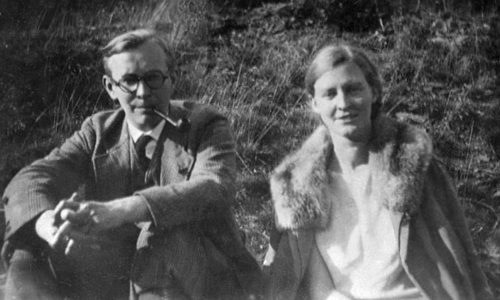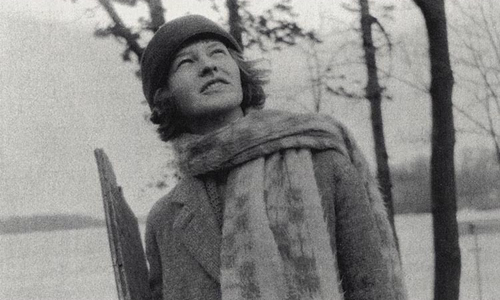Among the prominent members of the Red Choir, the famous anti-fascist German spy network, was a woman named Mildred Harnack.
Mildred Fish Harnack was born in Wisconsin, USA to a German immigrant family and was a lecturer in German literature at the University of Wisconsin-Madison. There, she met and married German economist Arvid Harnack, then moved to Germany in 1929.

Arvid and Mildred Harnack in Germany in 1930 Photo: UW-Madison.
Arvid comes from a prestigious family, with many people being teachers, lawyers, and economists. In the early 1930s, he began a relationship with the elite in Berlin. Like many others during the Great Depression, Arvid was fascinated by the Soviet economic model, the country unaffected by the crisis, and sympathetic to communism.
Mildred was like-minded to her husband in political matters. Together, about 50 economists and teachers formed a research group on the Soviet planning economic model, shortly before Adolf Hitler became German chancellor in 1933.
After the fascist boss took power, their group was forced to disband. Because the group's existence was not entirely illegal, the members escaped Hitler's persecution.
During the first period of Hitler's rule, the Harnack had a stable life when Arvid applied for a job in the German Ministry of Economy, while Mildred worked as a translator and a lecturer of English language and English-American literature.
In addition, Mildred contacted with American organizations abroad, traveled with her husband to the Soviet Union, and returned to the United States in the second half of the 1930s. On this journey, the couple met some influential people, in which many people carry liberal ideas and hopes for Hitler's downfall.
The Harnack family then went on to set up a discussion group on a wide range of topics, including the future of the country and German politics, in the presence and absence of Hitler. This is a dangerous action because some discussions have been identified as having anti-fascist content, putting them at risk of arrest.
In 1936, Arvid and Mildred and their group came into contact with the couple Harro Schulze-Boysen, an officer of the Luftwaffe. Harro and his wife Libertas are both from aristocracy and have insight, not only about the military but also the aristocracy as well as the working class.
Libertas worked on the film production department of the German Ministry of Propaganda and witnessed firsthand how the Nazis exaggerated the truth, or simply deceived the public. Harro, meanwhile, has taken on various positions in the Luftwaffe, having access to many of the forces' secrets.
In the late 1930s, Harro contacted the Soviets, offered them information and was welcomed, leading to the birth of the Red Choir spy group, the name given to Germany's Gestapo secret service. nazi set. Harro also tried to approach the Americans, but the anti-German sentiment made American intelligence suspicious and refused to cooperate with him.
The Red Choir was considered the most successful anti-Nazi spy network in World War II. The circumstances of the members of the network are diverse, from workers to officials, but united by the desire to oust Hitler.

Mildred Harnack in 1923 Photo: UW-Madison.
The Red Choir has never gathered in big meetings because it's too dangerous. Instead, each took advantage of random opportunities to meet other members.
After the meeting in 1936, the Harnack became friends with the Schulze-Boysen family and many members of the spy group. Through them, Arvid sent the Soviet Union information on the economic and production situation in Germany. Harro and the Harnack couple tried to gather information for Western countries before World War II broke out, but only the Soviet Union listened to them.
The Red Choir provided the Soviet Union with a wealth of information about Germany's intention to invade. At first, the country did not believe it, but when the truth was revealed, the spy group was finally recognized by the Soviet government.
During that time, Mildred's main job was recruiting members for the network. Thanks to her multidisciplinary work experience, such as society, education and literature, she knows many people and contributes greatly to the development of a spy group. However, this heavy responsibility greatly damaged Mildred's psyche, causing her to experience extreme stress accompanied by headaches and stomach problems.
In the period of 1941-1942, the Red Choir continuously sent information to the Soviet Union, but unfortunately was captured by German secret agents Gestapo. In July 1942, Gestapo successfully deciphered the code of a negligent operator during the operation, then quickly launched a campaign to arrest members of the group.
The Schulze-Boysen couple were arrested on the last day of August 1942 and the Harnack family suffered the same fate a week later. They were blocked on the north coast of Germany, supposedly trying to flee to Sweden, the neutral state. Many other members of the Red Choir also did not escape Nazi Germany.
The Schulze-Boysen and Harnack families were executed in 1942 and 1943, respectively, by hanging from their pianos with piano strings, a measure thought to inflict pain on the victims. Mildred was initially sentenced to six years in prison for a supposedly less important role, but Hitler personally intervened and ordered her to be executed.
Their bodies were later tested and dissected by a German scientist. So far their remains have not been found.
The members of the Red Choir were later honored as heroes in the resistance against Hitler. Their lives and victories are commemorated throughout Germany with many statues, street names and memorials.



 SkyMoeSkyMoeEi
SkyMoeSkyMoeEi







